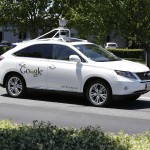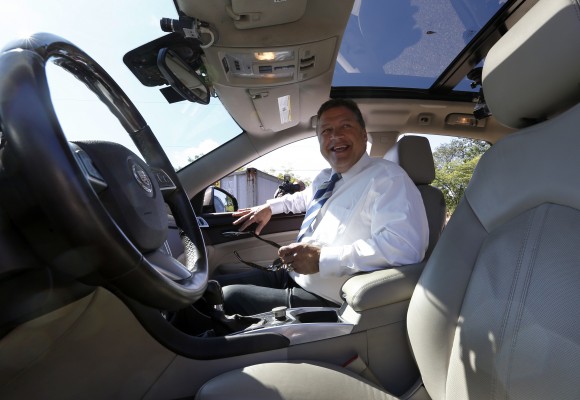Way back in 1988 it probably seemed like the idea of self-driving vehicles was about as far off as flying cars or hovercraft.
That was the year California voters enacted Proposition 103, giving among other things an insurance commissioner the authority to approve property/casualty rates and establishing rating criteria based on a driver’s safety record, miles driven annually and driver experience.
Years later Prop. 103 has withstood legal challenges and proposed measures to alter it – as well as withstanding many a beating by some in the insurance industry who believe the law was not the consumer-friendly measure its proponents sold it as.
But now some see it standing in the way of progress.
 At a hearing on autonomous vehicles held by Insurance Commissioner Dave Jones in Sacramento this week several experts testified that with the technology to build self-driving cars upon us, regulations and insurance need to get up to speed.
At a hearing on autonomous vehicles held by Insurance Commissioner Dave Jones in Sacramento this week several experts testified that with the technology to build self-driving cars upon us, regulations and insurance need to get up to speed.
Many of those experts stated that Prop. 103, California’s primary auto insurance regulatory bedrock, will make it difficult to adopt laws and insurance rates to deal with these vehicles.
During the hearing there was plenty of praise for the new technology and excitement about the possibilities it creates.
Jones, who was evidently late for the hearing due to a traffic jam, kicked off the hearing a half-an-hour late on a light-hearted note and an expression of his support for autonomous vehicles.
“I apologize for the late start,” Jones said. “Perhaps if more self-driving cars were on the road I might have been here on time.”
Jones said he recently had the opportunity to be driven for 25 minutes in an autonomous vehicle that navigated a complex inner city streetscape, “and it did so flawlessly,” he said.
“I think that this technology holds great, great promise,” he added.
Jones said he believes that having more self-driving cars can reduce human error behind the wheel and provide safer highways with fewer accidents, injuries and fatalities.
Experts on technology, insurance and driving laws who offered their thoughts on autonomous vehicles largely agreed on possibilities for a safer driving world.
Alain Kornhauser, a professor of operations research and financial engineering at Princeton University, likened anti-lock brakes and electronic stability control to the first steps an autonomy in cars and said further steps toward autonomy will reduce accidents as well as financial liability.
“Insurance has a great deal to save and gain from the integration of these technologies” he said.
Kornhauser suggested that at some point in the future as such technology drives down claims costs insurers or insurance regulators may even consider incentivizing policyholders to purchase autonomous vehicles.
“This has to be the idea arbitrage opportunity for the insurance industry and its regulators,” he said.
Most insurance experts at the meeting agreed autonomous and even semi-autonomous vehicles have the potential to reduce claims costs, but many pointed to Prop. 103 as the biggest hurdle to enabling insurers and insurance consumers to realize any savings.
“Unfortunately California has not positioned itself to nimbly adjust its insurance rates so its savings can be passed on to consumers as these cars develop,” said Robert Peterson, director at the Center for Insurance Law and Regulation at the Santa Clara University School of Law.
He argued that among the regulations created by Prop. 103, the 20 percent good driver discount most directly flies in the face of an autonomous car owner because at some point there may no longer be good or bad drivers, just good autonomous vehicles and bad autonomous vehicles.
“Proposition 103 is driver-centric, it is not vehicle-centric,” Peterson said.
Richard Holober, executive director for the Consumer Federation of California, wants to put a kybosh on any ideas of changing Prop. 103.
“We do believe that there is considerable room within Proposition 103 to address autonomous vehicles,” he said, adding that as long as there’s steering wheel a driver can take over by choice or by necessity, then a driver’s safety record will continue to matter.
He emphasized that Prop. 103 cannot be legally changed without a vote, or through legislation that doesn’t clearly advances the consumer protection of Prop. 103.
And if autonomous vehicles do yield fewer accidents then they should be considered loss mitigation tools, which should be a savings to consumer and not just “a windfall to insurers,” he said.
Hilary Rowen, a partner at Sedgwick LLP, thinks the one of first things that should happen is that perception of autonomous vehicles needs to change in the eyes of lawmakers, insurers and the general public.
“What it really is, or will be, is a street legal robot,” she said.
Once everyone has their heads around that, they’ll be able to better see the good and bad the new technology brings with it.
Thought of that way, from an insurance law perspective, Rowen said, not only will autonomous vehicle crashes yield causation arguments – was the crash a result of faulty software, or a bad decision by a driver who took over and tried unsuccessfully to avert the accident? – but in ratings factors there will be questions numerous to be answered.
What kind of miles are being driven?
“The miles driven under autonomous control are much safer miles,” she said.
However, transition miles – those are miles driven in which a driver is taking over control of the vehicle – may be considered unsafe miles.
Those are ratings factors that aren’t spelled out in Prop. 103, and Rowen recommended considering amendments to Prop. 103 to bring it in sync with modern technology.
Following the meeting Rowen noted that there is no part of Prop. 103 that prohibits insuring autonomous vehicles, but ratings factors like mileage, as currently spelled out in the law, may become less relevant with autonomous vehicles on the roads.
Driving records may also become a moot(ish) point.
“Your personal driving record is likely to be less good of a predictor of whether you are going to be in an accident,” she said. “Instead, the make and model of car may be a better predictor.”
How long someone has been driving may also be deemphasized as more autonomous vehicles roll out.
For example, if person A has been driving 20 years, but they are new to driving an autonomous car, is person A safer than person B, who has been behind the wheel 10 years, half of which they’ve spent in an autonomous car?
Eventually there will be plenty of data to answer many of these questions, but in the first few years after self-driving cars start hitting the roads there may not be enough information on which to base ratings, Rowen said.
“I would say in the short-term at least the intermediate solution is going to be to modify the regulations,” she said.
Until then whether Prop. 103 may need some tweaking at some point, or if it needs major changes through new legislation – which would probably face a court challenge –the insurance commissioner has “considerable latitude” as to how Prop. 103 is implemented, Rowen added.
Establishing rates is already difficult under Prop. 103, which is why Cathy Schwamberger, an associate general counsel for State Farm, believes the advent of self-driving cars will make the process even more difficult for insurers.
“At the beginning insurers will be challenged to gather the loss experience that we need to establish a price that matches risk,” Schwamberger said.
She also argued that there is no guarantee that with the number of crashes reduced that claim costs will go down.
Accidents involving autonomous vehicles be more severe and therefore more costly, and will the cost of fixing such vehicles may be higher as well, she said.
“Will there be repairers equipped to do the repairs?” she added.
Basically what the industry wants is some regulatory clarity when it comes to autonomous vehicles, said Matthew Gilbert, the California auto product manager for Nationwide Insurance.
He noted that “no two miles are created equally,” which refers to various driving conditions. In the future there could be even more conditions to consider in ratings, he added.
“You might want to have one set of rates for a semi-autonomous mile and another set of rates for a fully autonomous mile,” he said.
Topics California Auto Legislation Tech Personal Auto
Was this article valuable?
Here are more articles you may enjoy.



 Four in New Jersey Face Charges in Alleged $250K Travel Insurance Scam
Four in New Jersey Face Charges in Alleged $250K Travel Insurance Scam  MAPFRE Accuses AAA of Violating Long-Time Exclusive Marketing Agreement
MAPFRE Accuses AAA of Violating Long-Time Exclusive Marketing Agreement  Disney Worker Injured Trying to Stop Runaway Boulder at Indiana Jones Show
Disney Worker Injured Trying to Stop Runaway Boulder at Indiana Jones Show  Is the AI Boom a Bubble Waiting to Pop? Here’s What History Says
Is the AI Boom a Bubble Waiting to Pop? Here’s What History Says 

